In a time of great spectator enthusiasm for STOL competitions, wouldn’t a VTOL be even better? If a super-short takeoff is cool, why not vertical takeoff?
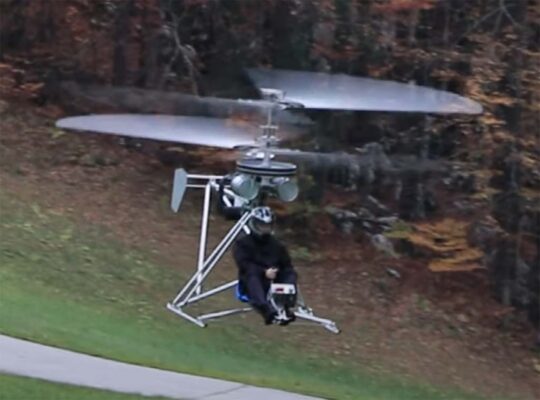
What if you could take off vertically this year and for a price you can actually afford?
Of course, rotary-wing enthusiasts can already choose a well-proven, made-in-the-USA helicopter that complies with Part 103 and is very affordable… for any aircraft type, but almost absurdly low-cost compared to conventional helicopters. I refer to the Mosquito XEL from Composite FX (see this video), which sells for $52,000 ready to fly or $42,000 in kit form.
Could Mirocopter save you even more?
Mirocopter Coaxial SCH-2A
Composite FX’s XEL Part 103 helicopter uses a conventional configuration with single rotor and tail boom. Anyone with helicopter experience as needed to fly XEL or SCH-2A safely has almost certainly flown tail boom rotary. Coaxial is different; no tail boom is needed. See this earlier article for more on coaxial.
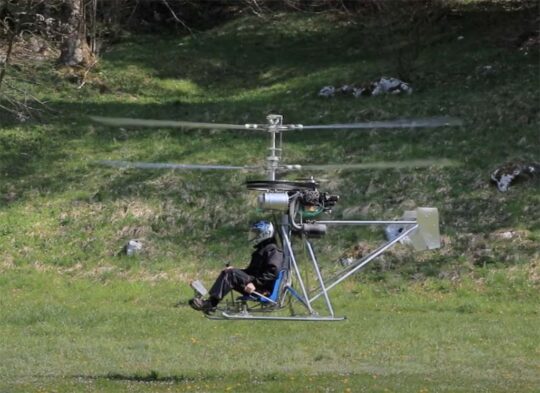
Miroslav wrote that his SCH-2A is “one of the lightest manned coaxial helicopters in the world.” He adds that it “is compliant to FAA’s Part 103 ultralight vehicle rules.” See specifications below.
He added, “SCH-2A [has been] tested for more than 10 years.” YouTube video shows the aircraft in slightly different configuration flying in 2017. “SCH-2A boasts very good flight characteristics including effective autorotation,” Miroslav stated.
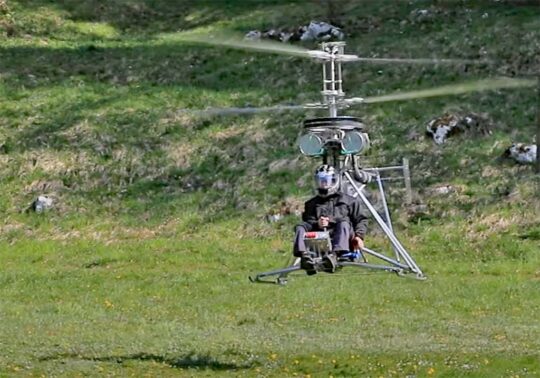
Mirocopter SCH-2A is powered by a Chinese-made Fiate MZ202 two-cylinder, dual-ignition, two-stroke gasoline engine. The MZ202 engine provides more than 60 horsepower at 5,800 rpm, the “nominal engine speed on SCH-2A.” The full Fiate MZ202 engine package comes with with electric starter, electric generator, dual ignition, exhaust system, and modified fan cooling system weighing only 66 pounds.
“SCH-2A is equipped with Mirocopter-modified NACA0012 aluminum composite rotor blades,” said Mirocopter. The rotor’s leading spar is made of extruded and anodized high-quality aluminum, the company said with inserted stainless steel bars used for rotor blade reinforcement and correct rotor blade weight balance. “Our rotor blades are durable and have a safety factor higher than 3,” noted Miroslav.
American Representatives
Two men are offering the Mirocopter SCH-2A in America. Each is awaiting delivery and they are hopeful to make a showing at EAA AirVenture Oshkosh 2022. (These days with snarled supply chains and shipping dock delays, forecasting exact delivery times is nearly impossible.)
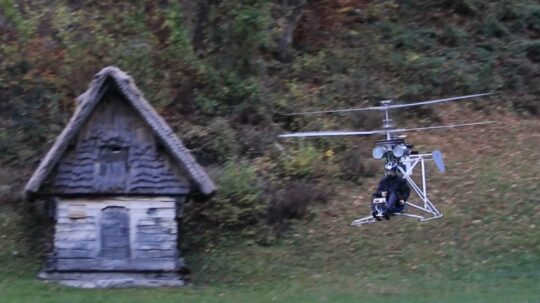
Mark will handle the western U.S. from Murrieta, California. Contact him by email, or call 951-491-9002, or check out his Rototrek website.
Andrey is based in central Florida. Use this link to email him.
Is this a Bargain? — Mark stated, “At $33,750, the Mirocopter SCH-2A is the lowest cost production helicopter in the world! The SCH-2A is fully built and is not a kit.” He added, “A 50% deposit is required to reserve a production slot. The remaining 50% is due ten days prior to shipping. DHL shipping is estimated to be around $3,000.” (As with all prices, that shipping quote is subject to change; check with Mark using the contacts above.)
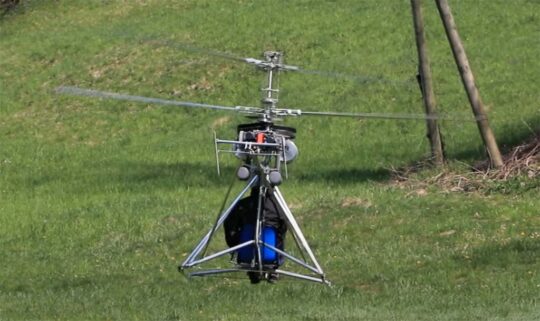
“I chose to resell this coaxial ultralight helicopter because I think it is the best solution for personal VTOL flying for several reasons.” He listed them for us:
- Coaxial is easier to fly than a conventional configuration. When you pull collective you aren’t concerned with torque like in a conventional helicopter. If it is easier to fly, it is a bit safer, too.
- Coaxial can lift more weight so bigger pilots can fly it.
- Coaxial is quieter because it has no tail rotor and can run the engine at a lower rpm for the same weight.
- By lifting the same weight at a lower RPM you burn less fuel and the engine will last longer.
- Coaxial has a smaller footprint because the rotor diameter doesn’t have to be as big and there is no tail rotor sitting outside of the rotor diameter.
- Coaxial has a 20% slower decent rate in autorotation than a conventional helicopter.
- The price of the Mirocopter SCH-2A is about two-thirds the price of a Mosquito.
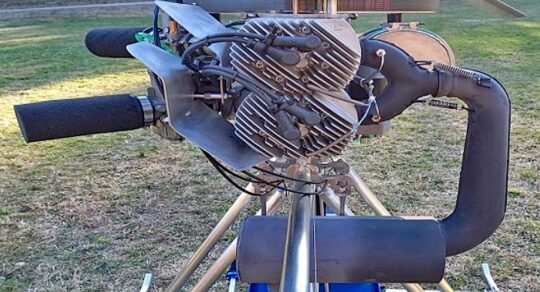
Although prototype SCH-2As have been flying for a decade according to Miroslav, Mark reported, “The first production SCH-2A helicopters will be tested this month before delivery so less than 10 will have flown before June 2022.”
He reports estimated lead time once you place an order to be 4-5 months.
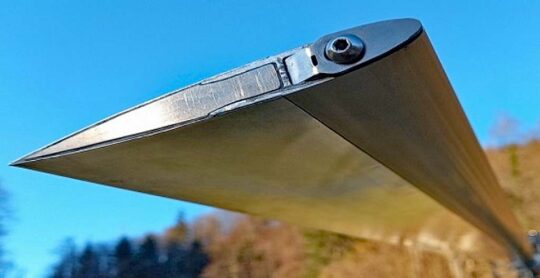
Andrey largely concurred with Mark’s statements about Mirocopter SCH-2A.
“My experience with coaxial helicopters is limited,” he admitted, though such a statement is true even for highly experienced helicopter pilots.
Before settling on Mirocopter, Andrey checked out two other similar designs. However, both are made in the Russian Federation and were designed to fit Part 103 (Russian 115 kilogram), However, for Andrey, that Russian heritage introduced a barrier.
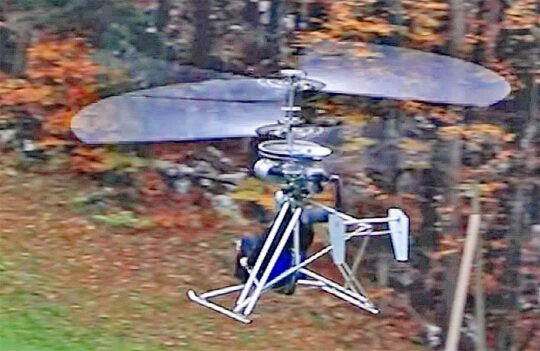
“Miroslav was designing that helicopter for years,” said Andrey. “He worked really hard to pick up the right suppliers and finally worked closely with Anhui Fiate Aviation Co.Ltd., of China to select the powerplant. In fact, that is how I came to the distribution channel. I was working with that supplier as well.”
Andrey reported, “I personally flew a Rotorfly in 2010. I have about five hours on it.” He continued, “I have never flown SCH-2A but I don’t think that will be an issue for me. I am a fixed wing pilot working on my instrument rating.
Andrey has a Facebook page where he posted, “We are proud to announce the availability of Mirocopter SCH-2A. With the required care, SCH-2A helicopter will provide you a reliable and enjoyable flight for a very low operational and maintenance cost.”
Mirocopter SCH-2A
Ultralight Helicopter
TECHNICAL SPECIFICATIONS
- Empty Weight — 249 pounds (113 kilograms)
- Maximum Pilot Weight — 273 pounds (124 kilograms)
- Maximum Takeoff Weight — 551 pounds (250 kilograms)
- Maximum Speed — 62 miles per hour (100 kilometers per hour)
- Cruise Speed — 50 miles per hour (80 kilometers per hour)
- Engine — Fiate MZ202
- Power Output — 60 horsepower
- Fuel Tank Capacity: 5 U.S. gallons (19 liters)
- Cruise Fuel Consumption: 4.5 U.S. gallons per hour (17 liters per hour)
- Maximum Cruise Flight Time: 1 hour
- Overall Length: 14.3 feet (4370 millimeters)
- Overall width: 4.9 feet (1500 millimeters)
- Overall height: 8.0 feet (2450 millimeters)


Having th 55 experience gives an appreciation of the belts. Are any units available to view in MD on a field trip?
There is one in PA that you can look at. The company is called Scout Aero and you can find the contact information here:
https://mirocopter.com/en_US/distributors/
David J. Alt from Finksburg Maryland. I worked for the Electric Company retiring at 50 years old. I have my private license for airplane in 1989 and flew planes for three years. I took training in Robinson R22 and got my private helicopter license in 1992. I bought a Brantly B2b Helicopter two weeks after getting my helicopter license. I flew the Brantly B2b helicopter for three years and sold it to an experience helicopter pilot. A month later I bought a 1957 Bell G helicopter from NE pennsylvania flying it back to my home in Maryland. I got my Commericial Helicopter License three months later. In 1997 I work give helicopter rides three weekends every month from April thru September for 4 years. I put fiberglass tail rotor blades on the Bell 47 and it flew Great. I sold the Bell 47 helicopter in June of 2004. I have experience in Hughes 500 B&C models, as well as Bell 206 B model. I purchased a second Brantly B2b in June of 2004 and flew it every week. Mark your amazing.!!!! Dave
Thank you Dave!
Interesting comments on the microcopter. We will most likely find our reality somewhere between the early adopter optimist and the pragmatic skeptic. Time will be the teacher and skin in the game (= $$$$$) will be the closer. Personally, I prefer an electric propulsion option but until that hot tamale has been properly sorted, I am ordering mine yesterday!
Hi,
If I need to buy in kit form, is it possible? Are drawings available for Do-it-yourself?
I stay in Thailand. I can import the engine from China, if vital components can be imported from the manufacturer in Europe. If I can import the [airframe] structure I can design in Thailad. Kindly let me know the feasability and cost.
Please use links in the article to ask the manufacture directly. You will have to work closely with them to achieve your goal.
Manufacturer’s reply is a single sentence reply, not having a broader business goal. The spares would be hell if we buy from such restricted access manufacturers.
I am commerical helicopter pilot with 1900 hours in helicopters. I have giving helicopter rides all day saturday from 8 a.m. under dark. And all day sunday from 8 a.m. until dark. Very Nice looking Co-axial helicopter. Thanks Dave
Mark, David J. Alt from Maryland. I flew airplanes as a pilot from 1989 until 1992. I then took training to fly helicopter in 1993 becoming a private helicopter pilot in July of 1993. I bought a helicopter in August of 1993 and flew it for three years. I sold it in 1996, buying my second helicopter in July of 1996. It was a Bell 47G and obtained my commerical Helicopter License in August of 1996. I gave helicopter rides three weekends every month getting a lot of flying time. In June of 1999 getting much experience flying a Hugh 500-C and Bell 206 Jetranger. I sold the Bell 47G in May of 2005 which was a Great Helicopter with fiberglass tailrotor blades. I bought a Brantly B2b Helicopter in June of 2005 flying it everywhere. Your Coaxial Helicopter Looks Great – But Everyone has to maintain it RIGHT!!
Nice job on this one. So I am a rotor CFI with over 1200 hours mostly in an R44, can I fly this right away, or is there still a training requirement? Are y’all still at Oshkosh? Where is the U.S. dealership? Thanks
The aircraft remains on display at Oshkosh this weekend. Links to the representatives were provided in the article.
how do i get to the man selling the sch-2a in fl
Here is the email address that appeared in the article: andrey.vegger@gmail.com
Absolutely Amazing… What other ultralight anything (other than a parachute) can offer a seat to a guy at 273 pounds?
While I can’t make it Airventure you can bet I”m gonna be getting to know Mark in Murieta. Alaska will be one interesting market for this machine…
I live and fly in Alaska. Several guys here have Mosquito’s, but haven’t seen anything coaxial. I am a retired Military and EMS helicopter pilot and would love to park my butt in one of these. Support is a big deal here with Aircraft Spruce and Specialty having just built a large, new facility and bringing in more inventory for the builder, but they don’t carry much in the way of experimental parts or helicopter for that matter. I used to work for them. They are also setting up shop in Australia this next year.
The possibilities are endless and it would be a great summertime flying opportunity. Gives back country fly fishing a whole new meaning.
Need a distributor in Texas? This looks like fun!
Cost?
As it says in the article: $33,750
My next toy. Lessons first.
What about: 1. autorotations? Have numerous autorotations been performed? If so, how many? And from what altitude? And what is it like settling onto the ground from an autorotation? Is there any chance of tipping the craft over from an autorotation once on the ground? 2. Ignition system; dual? And what type of ignition systems? 3. Time before overhaul (TBO); of engine and drive components? How many hours for each before replacement or overhaul?
Hi Terry,
We are hoping to get new autorotation videos this month. We will perform autorotations all the way to landing to answer those questions.
The engine is the MZ202 which is the same as on the mosquito helicopter and it does have dual ignition. From the MZ202 manual: A 13.8 volt, 180-Watt alternator serves the ignition system and is used to re-charge the starter battery. Electronic double ignition switching type with variable automatic timing guarantee reliability, safety and optimum engine performance.
TBO of engine is 500 hours. From the Mirocopter user manual: Life time of the SCH-2A coaxial helicopter and other vital parts like ball, roller and spherical bearings if used under normal conditions of operation is calculated to be 1000 hours. After this helicopter operation time, extensive overhaul is required.
Here is some more clarification on maintenance:
Belts
Both belts must be changed after every 250 hours of operation or in case that any cracks, damages
on ribs or worn surface appear.
Control Cables
Cyclic pitch, yaw, throttle and chock cables must be changed after every 250 hours of operation or
in case that cracks or damages appear.
Bearings
All 4 rotor blades main spherical bearings must be changed every 250 hours of operation or if any
sign of wearing appears.
Estimated cost of 250hours TBO is less than 500 USD.
Thanks. Not bad. My experience with a Rotorway does not have the longevity of parts you have listed. So you truly have a real long lived helicopter. As good or better than any helicopter flying it appears.
Are you folks planning to maintain stock of such parts to support these 250hr maintenance intervals? What additional parts and costs are projected for the 1000hr overhaul interval? Are we talking about the coaxial drive gearbox itself, or just engine and ignition parts?
What about a hybrid conversion kit to replace the 60hp 2-stroke ICE with an electric direct drive that also eliminates belts, ignition, and alternator; and replaces the starter battery with one of higher capacity for pure short-term electric drive when the hybrid ICE generator is dormant? That would also add flexibility about the type of generator engine and fuel, possibly a diesel burning SAF kerosene or even used cooking oil. That would enable quieter TO&L by operating the ICE only at higher AGL where noise is of less concern. Of course, direct electric drive could also eliminate the coaxial gearbox by using a separate motor for each rotor.
Some of the above suggestions reduce weight while others add it, making the calculation of maximum weight to meet current Part 103 UL requirements questionable. But I suspect waivers may be obtainable for a good hybrid design.
Okay…. New to the “Rotax” Coaxial world…. Can you PLEASE recommend an affordable Coaxial Engine, Drive-train and Rotor-caps….???? Looking to try building my own Craft…
Thanks,
Mike
Way over priced.
Compared to what? Try and find anything new at a similar price. Does not exist in my experience. Or you are like me and prefer buying used that has been kept in good condition. Except, used does not come close to anything that is new for reliability. But, the beauty of used aircraft, with annual inspections, used is at least 90% of new usually but without shiny. And the aircraft market has never recognized this fact. So like you, I will always probably buy used because it is where the value is located with only a marginal risk addition, if any. Thought I should back you up, even though your response is just wrong without the above explanation.
What is the service ceiling? I live in the Rocky Mountains.
For a 273 pound pilot it can hover out of ground effect at 5,500 feet. But if you weigh less that number goes up.
How about a complete response? The Rocky Mountain airports are above 10,000 feet MSL. Which means you need to tell her how much less weight; or how much larger of an engine is required to hover up to 11,000 feet MSL. And if control changes are required. I would think the rotor blades would need to take a bigger bite of air to hover at 11,000 feet MSL requiring more horsepower to do so.
The specifications are that it will hover a 273 pound pilot out of ground effect at 5,500 feet and it will hover that same pilot in ground effect at 6,500 feet. The Mirocopter will fly at much higher altitudes, but to land a 273 pound pilot you would need to be at 6,500 feet or lower. My second customer lives in Colorado and lives just east of the Rockies at 5,500 feet. He weighs 175 pounds so is confident he will be able to fly most days of the year. He will receive his Mirocopter in the first half of July. Of course, we will have to wait and see how it performs.
Terry brings up a point regarding power and density altitude. Just like any other normally aspirated engine, density altitude has an effect on performance. Something some of our non-helo operators may not understand is rotorblades also have limitations when it comes to density altitude. Taking “big bites” out of the air in fact does cause a larger power demand, but it also places aerodynamic limitations on the rotor blades called vortex ring state or settling with power. I bring this up for two reasons:
1. To emphasize the need for instruction in rotorwing aerodynamics before flight, (since solo is the only configuration 103 allows); they differ from fixed wing in their application.
2. To ask the question: Are there certain aerodynamic disparities between conventional RW and Advancing Blade Concepts in coaxial aerodynamics?
Where can you fly and what range?
This is an ultralight so you have to follow FAA Part 103 regulations. The main thing is you have to fly over uncongested areas. The Mirocopter will cruise at 50 mph for 1 hour, however it can fly faster than that.
Talk to a flight instructor. You should have a sectional chart and/or the nearest class B airspace chart. You should be well familiar with your local airspace before venturing here at this location. At least ground lessens to become familiar with aircraft charts are a necessity for you! You do not want the FAA coming for you because you inadvertently entered class D, C, or B airspace! The FAA will tell you there is no excuse for this kind of infraction. And if you make it, it will probably cost you in more ways than one. If you think you can outsmart them; I would think again if I were you. Pilots generally are the most responsible people on the planet and why I take the time to ensure you are one of the most responsible people on the planet.
Obviously, someone with minimal aviation experience in general. This is obvious to any pilot, especially to a helicopter pilot with any experience.
What type of fuel is required and if capability to modify for more stringent regulations?
This can fly on high-octane automotive gas. The engine is 2-stroke so you have to mix oil with the gas. It does have the capability to be modified.
What kind of modifications are you talking about? For what purpose?
I would expect it may be modified to oil induction like a snowmachine
I need this thing. Big time
The Mirocopter SCH-2A reminds me of the Part 103 RotorSchmiede from Germany (the “VA115”), and the Part 103 CoaX from Australia. Very similar designs to this Mirocopter SCH-2A. Unfortunately neither of those other two offerings have made it to the U.S. I’m not sure they’re actually being sold anywhere, to be honest. I think it’s the typical “Great idea, but lack of funds to fully execute” problem we see so often in light aviation. Bringing any light aviation product to market is often a massively expensive undertaking with no small amount of risks. It’s difficult to scale to a point where money can actually be made.
Nonetheless this segment of Part-103 eligible coaxial helicopters is exciting! They’re relatively easy to fly, relatively inexpensive, and with coaxial rotors possess flight dynamics that are about 30% more efficient than conventional helicopters. While eVTOLs are cool, as Dan pointed out, they are very expensive and – at present – not particularly practical given battery (flight duration) limitations. Here’s to hoping Mirocopter finds some market success!
The good news is the first production units are being delivered to the US this month. The Mirocopter will be at the Rototrek booth at EAA AirVenture in July – come see us! Email me if you want more information.
I still prefer an eVTOL, the Opener Blackfly in particular; because they say they will sell them for the price of an SUV. And the 8 propellers, batteries, and motors; 4 on each wing; redundancy is greater than any other aircraft. At the price of an SUV, the Opener Blackfly is not expensive, relatively speaking. The next generation Opener Blackfly will have 12 KWH batteries, and a flight time of 50 minutes; as good as most other part 103 aircraft. And if you compare mechanical complexity of any helicopter to any fixed wing aircraft; even one with 8 propellers, motors, and batteries; a fixed wing aircraft wins hands down over any helicopter; will last at least 2,000 hours, probably 4,000 hours before major overhaul on a Blackfly eVTOL. But, all to their preferences; and I have mine as detailed here and why!
So with contra rotating propellers, no torque to be concerned with. Or should be easy to fly. The problem with helicopters compared to fixed wing aircraft is maintenance. Those turning shafts to the main rotor do wear out. So knowing how long they will last and how much to replace them is important. And hull insurance on a helicopter is 1% to 2% of the aircraft value. Fixed wing hull insurance is around 0.5% to 1% of the aircraft value. Also engines on helicopters, at least internal combustion engines, due to higher heat loads wear out quicker. So knowing the TBO for the engine is also extremely important. And since no belts appear, the drive train must be gears; which also wear out and need to be replaced. And knowing how long they will last is also important. So the question of owning one of these is not as strait forward as it appears. Hidden or non obvious costs dominate with any helicopter. The plate below the lower rotor blade appears to be for a belt?
The Mirocopter has a belt driven transmission which saves weight and is easier to maintain. The engine is the MZ202 (which is used on the Mosquito helicopter) and has a TBO of 500 hours. Email me if you have more questions. mark.rumsey@rototrek.com
While Rotorway may have gotten better at it; their tail rotor belts need to be tightened every 5 to 10 hours; just unacceptable. And the Rotorway main drive belts are better; my memory say re-tightening every 25 hours; also not acceptable. So I am jaded when it comes to belts on helicopters. And your promises of tightening intervals of belts are probably closer to Rotorway intervals. Or, believing your belt tightening is significantly longer than Rotorway belt tightening is figuratively a stretch. Or not believable. And this is a safety issue because it is easy to supposedly tighten a belt and then have it prematurely loosen up due to not tightening properly the bolts that hold the belt. And you will not know this until the belt starts slipping and you have only partial control. A crashing scenario; to be avoided like the plague. Or for me, belts are no! NO! Because I value my life! Or find out in your own way! And hopefully, it will not cost a life!
Who yanked your chain? You act like all of us should suffer your intolerable need to give your worthless opinion, when no one asked you.
Why don’t you go to a Blackfly website and whine man! 99% of us here are excited about this.
Rotorway started out with a chain drive. That has a very bad reputation. Chains came apart, came off of their sprockets. The belt drive is the only way Rotorway was able to stay in business and have their helicopters not fall out of the sky all the time. You need fara more education about helicopters than you appear to have.
Amazingly in the wind. I’m interested to have one here in Kenya 🇰🇪🇰🇪
Just when you think that aviation has done it all and seen it all and there aren’t any more frontiers, someone comes up with something like this. Brilliant.
Looks how does it handle in wind?
Unknown, but gyroplanes are good in wind so I’m guessing this may be too.
I’d say based on weight you could run out of control authority (cyclic) pretty quick, but you can also aim into the wind and fly sideways. Touchdown from a hover might would probably be into the wind also. I’d say the issue is weight; it doesn’t take much wind to push 500 lbs around.
Just like other single seat helicopters they handle very well in the wind because of the low profile and minimal surface area. When flying the Mirocopter you shouldn’t take off in high winds because it will turn into the wind during hover because of the tail vanes and might be hard to control yaw.
Now THAT”S something!!!!! Will we possibly see it at Oshkosh?
Hopefully, yes, if the freight ships sail.
Hi Dane,
Rototrek will have a booth at EAA AirVenture. We hope to see you there!
Will your insurance allow anyone at Oshkosh to fly your helicopter? Probably not, but asking them in advance is worth it because you may sell a few of your helicopters because the person flew it at Oshkosh. No doubt it will cost you more for insurance to allow anyone to fly your copter but I presume you will have significant ground instruction, and perhaps a simulator, to make it easy for the insurance company to say yes. The Ultra light runway is always available, The only question is when? First thing in the morning or just before sunset should be doable; when everyone else is eating or sleeping. Based on past years there. Or, get in line also works; except most aircraft customers do not like getting in line to do anything.
We don’t plan to allow customers to fly at Oshkosh. We will have a demonstration flight or two though.
Rudder pedals?
Wind screen?
The article refers to rudder pedals, which move the surfaces at the rear. As you can see it has no windscreen.
Ultralight. 55kts max speed. Wear safety glasses. They don’t count as vehicle empty weight.
No wind screen? So if one accidentally gets caught in rain; the safety glasses are a necessity. Or in case of getting hit by bugs!
So think in terms of the helmet you might wear to ride a motorcycle moving at similar highway speeds. The “windscreen” is built in; no goggles required. Or think of a plexiglass face shield such as some were wearing at the beginning of the Covid-19 pandemic before masks became a demand. That would allow more flexibility to your choice of a lighter form of headgear — though rain might still present challenges if one were accidentally caught in a shower.